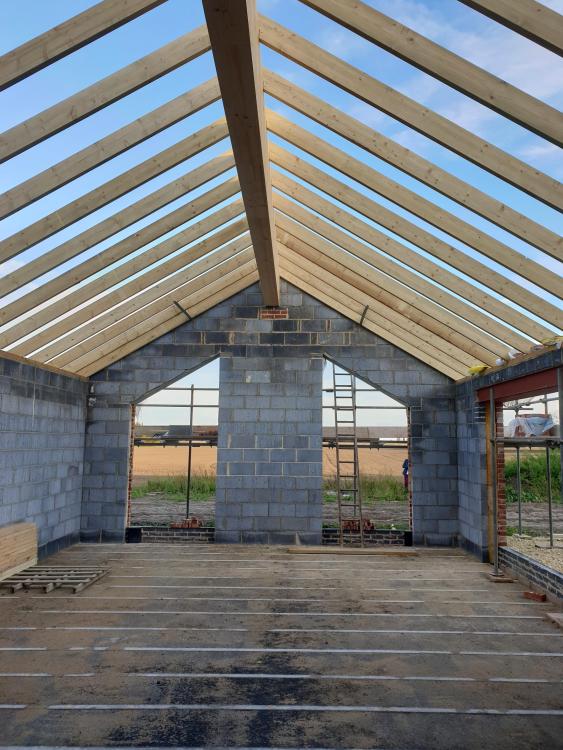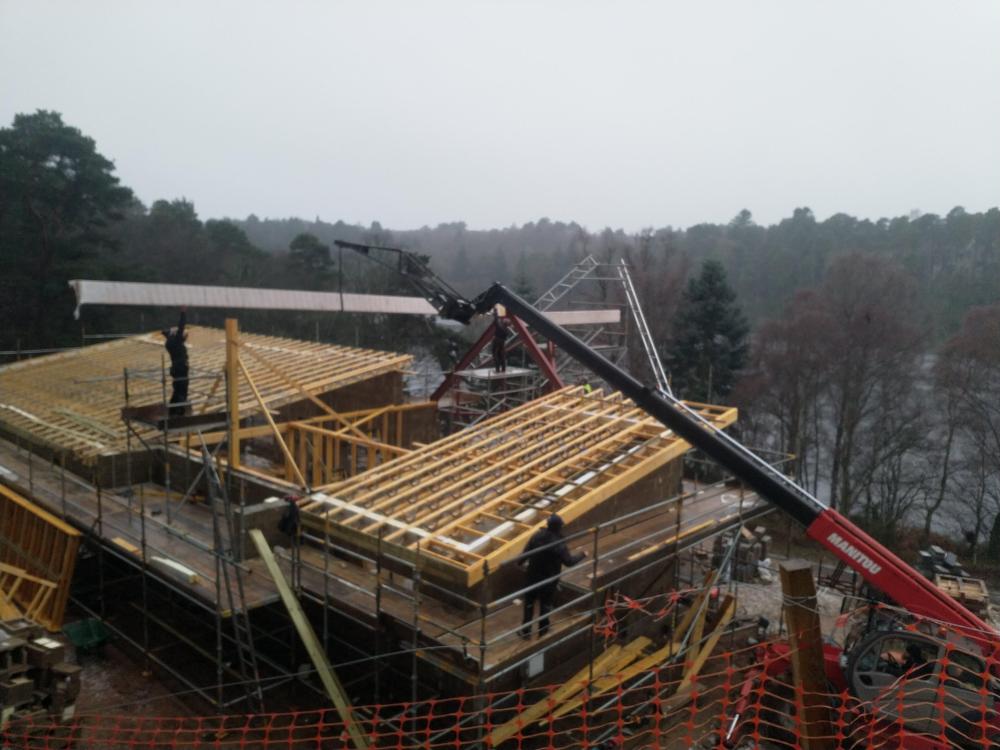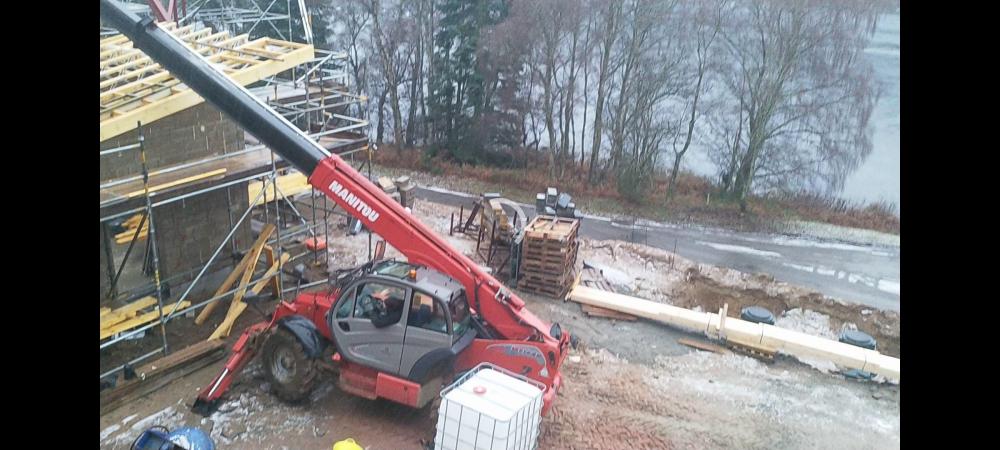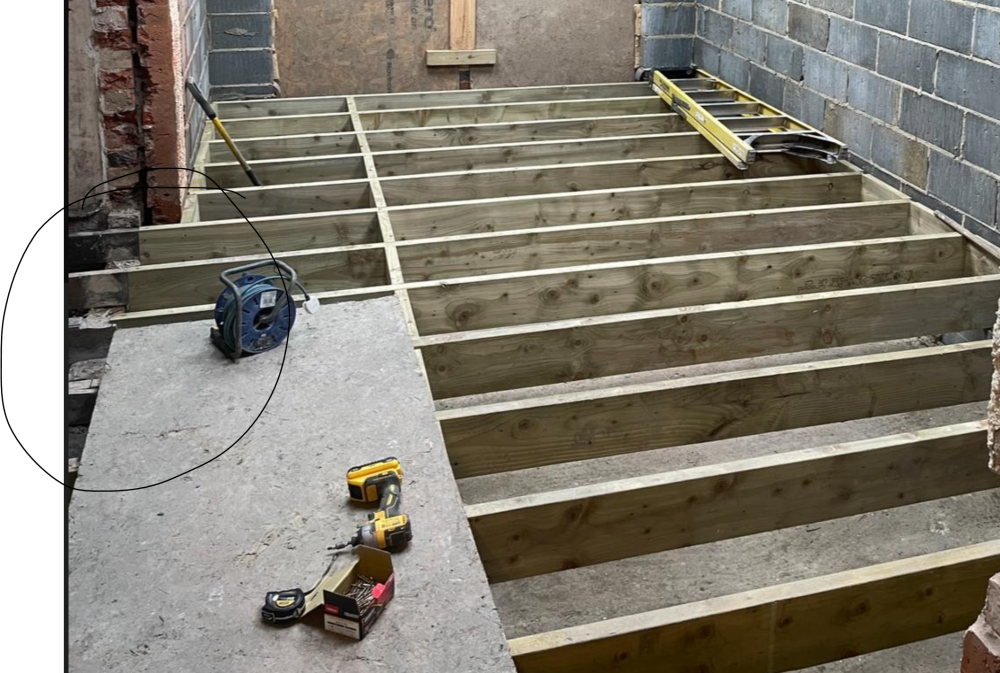Leaderboard
Popular Content
Showing content with the highest reputation on 03/19/24 in all areas
-
The timber frame arrived this week from the factory. There was a large crane onsite all day yesterday. Got decent weather, no wind and only a bit wet in the morning. The lads have the walls fully up, 1st floor done and a ridge beam in place. They are starting cutting the roof today as that is built in situ. Really surprising walking around the rooms after looking at drawings for years! The window openings are a LOT bigger than I ever thought though, huge would be the description! Had a lodger arrive already - neighbours cat performing 1st inspection! Thanks to everyone on BuildHub for their support, advice and inspiration from their own experiences to help me get this project off the ground after SO long!!2 points
-
@NandM why are you bothered and why are you questioning it. my point. unless the beam in question is made of unobtainiam and it’s a cost point you are arguing then. you will need some sort of beam, that’s a definite a timber kerto beam or laminated gluelam will not be cheaper than a steel beam. whatever you use you won’t be picking it up by hand, so it’s a telehandler or a crane, that’s for sure. the only thing I can see in your drawing that I think is pointless is the splice joint, a 10m beam can be made in one piece, it can be delivered on a normal truck, it doesn’t require an artic, so unless you are really tight for space I see no reason to make it in two parts. a splice joint could add £250-400 depending on number of holes and bolts used. all I would say is if you can go deeper with the size it could get lighter, maybe 45-55 kg a metre, so it ends up 500kg instead of 900kg. still needs a crane or a forklift though.2 points
-
Having now lived several years in a near passive house with it's low heating bills and constant comfortable internal temperature, my view of old houses like this has changed considerably. To properly upgrade it will cost a LOT of money. You either upgrade it, or pour lots of money into it every year in heating. I firmly believe that the market value of old inefficient properties like this should be much lower than a well performing house, to reflect either the high heating bills or the work needed to upgrade it. I am not saying don't buy it, but buy it with your eyes open, and I hope you are not the one owning it when the market finally wakes up and people realise poor performing houses really are worth less.2 points
-
2 points
-
+1 THIS, now is the time to overthink things, make lists & decisions - sleep on them - and re-visit and simplify a few times before finalising. It's going to be much cheaper now than after contractors are on board.2 points
-
it's not unusual to switch on the neutral like that, means each item's supply can be individually fused. Plus there's something in the back of my head that it's electrically "quieter" but I'm not sure where I'm recollecting that bit from, lol.2 points
-
Of course I also put seal around the edges. Well, it is one way to deal with an outside metal door that was either uninsulated or very poorly insulated. Is there really another way, given that the door couldn't be opened (it was soldered together)? 3cm-thick cork means R=0.75. A new, properly insulated security door would have cost around 4000 eur, or so the locksmith tells me (one can find somewhat lower values at https://www.m-habitat.fr/portes/prix-porte/prix-d-une-porte-les-tarifs-selon-le-type-1629_A) - and the R value would not necessarily be higher; any door with an U lower than 1.7 counts as insulated over here, and 0.75 is clearly greater than 1/1.7 = 0.588... I'm putting a home-made thermal curtain (lots of Climashield apex inside a William Morris curtain, with reflective insulation between the laters) on top - but the stuffing keeps sliding down; I'll need to take the curtain to a retoucheur.1 point
-
A lot of work? Why not just replace them all with nice new straight joists?1 point
-
Yes choose one system or the other. Not all dMEV units are equal. The Greenwood mentioned above was my second make, the first was quite noisy. Always seem to be plenty of Greenwood units on eBay for good prices. I looked when I was designing my house quite liked the Duco system https://www.duco.eu/uk-ie/products/mechanical-ventilation1 point
-
yep, I bought too and I'm not sure I'd ever get rid tbh. Far too handy...1 point
-
1 point
-
1 point
-
It really helps. A tip from our Welch wizard. @Nickfromwales1 point
-
You would be surprised how little a condition based system does. trickle rate for bathrooms/WC/utility is 5l/sec (21.6m3/h) and kitchen at 8l/s (28.8m3/h). Boost is only in the rooms requiring it So house 3 bathroom, utility and kitchen, trickle rate 115.2m3/h Ventilation heat loss = Qv = 0.33 × Air volume x ΔT 0.33 * 115.2 * 24 = 0.9kW at -3 OAT 90% efficiency MVHR at Scottish Building regs rates would, be 0.23kW at -3 OAT. So 670W difference dMEV advantages - No filters, heat exchangers and duct to pump through (supply and extract, only extract fans not supply fans. No filters to replace. Cheap to install, I paid £35 for my fan, used in my summer house.1 point
-
Judging by your description of the property, there may not be much competition with other potential buyers as it could be a step too far for lots of people with the amount of work involved. Is the property currently occupied? What's the state of electrics like? Take your rose tinted glasses off as I think minimum refurbishment cost will be 150k. and go north from there. Is the rest of the family as enthusiastic as you ? and are they willing to learn new skills and take on a 3 year project?1 point
-
1 point
-
Ditto. Apart from the main big jobs it was bought for, it was a damned handy thing to have, often just used for a short period. You would not hire a machine just to have sitting there to be used every now and then, so without your own machine you would either do without, or wait until you have enough jobs to hire one.1 point
-
Sorry I ment dodgy as in they have stopped trading. The German website looks more maintained/active.1 point
-
im not entirely sure, you'll have to use a bit of improvisation. At the very least id clip that MDPE pipe to that concrete wall. If its a cellar and not exposed to the outside temperatures im sure it'll be fine freezing-wise but if thats unlagged heating pipes then its a really poor show. Its an awful job from an awful plumber im my opinion.1 point
-
@Dave Jones the 22mm board is routed to fit the ufh heating in and so are the 6mm ply that went ontop. We had the option to put 12mm ply but the tiler says it would be fine with 6mm and the crackmat.. wish we’d gone with the 12mm ply. 🤬🤬🤬1 point
-
The size of the windows was the biggest surprise for us too! Progress is looking good! Love the window seat idea1 point
-
Yes. At a certain chunkiness they don't need any (or partial) protection. The one here for example is unlikely to need any. There is no occupation above it. At 300+ degrees it will soften a bit. @NandM Re the splice, and the rest, Russell is right. Ask the supplier for 2 options, in case it happens to suit manufacture or delivery costs (small lorry) But lift it in one piece. If the builder hasn't seen beams this heavy, he either hasn't much experience of beams....or some cash and no regulations clients have unstable houses. Either way, discuss the proposed method for lifting and fixing it.....a 'risk assessment'.1 point
-
@Nickfromwales, the cells in the dead one are blown so it is defo scrap. I can't see anyone wanting the working one unless they've already got one and want spares / cold swap. I thought I'd ask. @SteamyTea Nick, the concept is great, but as a friend summarised it: you've got a case of early-adopters curse.1 point
-
I should add, builders always say it's a big beam. They are designed on deflection, not strength. This is particularly important for vaulted roofs because deflection at the ridge manifests as an outward thrust at the wall plate, which is particularly not good for masonry.1 point
-
Not unless it’s a habitable room above it. as far as I’m aware.1 point
-
Apologies for late reply. I tested stixall extreme power on mf, wood and concrete block. Solid stick. Test 1 - used a piece of mf (had a tiny ~1mm lip on the adhesive side too). Applied stixall and placed it on top of the concrete block a brick on top of the mf to hold it down. Test 2 - used an even smaller and thinner piece of mf (quite flimsy compared to above). Applied stixall on one side and placed it on top of the concrete block. This time I didn't put any weight on top of the mf piece to hold it down. Test 3 - used a piece of wood and concrete brick on top of it to hold it down. Left it to cure overnight. All tests were successful, very solid. Only test 2 had a little play and I was able to see the clear adhesive between the two materials. This was probably because there was no weight to hold down the mf. It was still a strong grip. In all three tests, I could pick up the concrete block from mf/wood. Thank you.1 point
-
It's a very long span taking a lot of load. It looks right to me . The weight would reduce if you used a deeper beam (perhaps about 450 or 500 deep) instead of that chunky section. But deeper will likely interfere with your headroom/ aesthetics.1 point
-
Me too. It's already very noticeable in the test areaand would make a really nicely muffled acoustics in every room. Maybe I'll be able to convince her when I test spray it in one of the rooms so she can see what it looks like.1 point
-
1 point
-
That's not a change in regulations, that's a change in attitude. I agree you can get the "I can't design it for you approach" but equally the OP has a suggested solution - a short fixed ladder. That should be sufficient to open a sensible discussion with BC as to compliance. If you don't ask you'll never know.1 point
-
So demo yes you will be waiting a long time for a rebate. But if you use a vat registered company you are only paying them 5%. Landscaping you might choose to buy the plants in and heel them into the ground short term, and get the claim in. Make sure all your landscaping/ fencing etc. is part of the planning permission.1 point
-
A great stage to start this thinking rather that 6 months down the line. Keep an eye on this. Shrink the house to fit your budget with sone contingency. There will come a day when you need to throw money at it to overcome some obstacle. Passivhaus is designed to be an economic corner where the added efficiency gets rid of the need for a conventional central heating system. If it's costing £50k for £500 then you've done it wrong. Use the spreadsheets here to get a feeling for the balance of heating needs. Forget GSHP and battery's. Too dear Vs the benefit. Don't bother with the PIR internally. Just widen the cavity. Stainless steel ties are cheap enough. Use separate lintels for both leafs. 200mm cavities are the norm where I live. North facing glass is bad for energy efficiency. Careful with this. Airtighness is the lowest hanging fruit. It's a very big house, sub 1ACH should be very achievable.1 point
-
(PS: I'm going to stop replying on this topic, as we've hijacked the OP's thread)1 point
-
I think this would need glueing as UFH pipes are just below the surface 🤷♂️. However, if engineered oak (or another wood) flooring is glued down the extra ply would not be needed surely and would bond it all together and make the floor stiffer.1 point
-
1 point
-
I would suggest an 'Intelligent' membrane such as Pro Clima's 'Intello'. Expensive but good if it does what it says on the tin - and I have worked on the basis that it does!1 point
-
Yes, that's the one. I've heard horror stories about badly implemented slinky systems. I'm sure there was someone on BuildHub a couple/few years ago who had problems with the ground over their system freezing towards the end of winter. My main point is that there are only very limited situations in which a GSHP will make sense over an ASHP.1 point
-
1 point
-
To all those saying this is not poor reporting, JohnMo has quite nicely provided the price for an ASHP itself as £2,500. Not the £10,000 more than a gas boiler as quoted in the inaccurate reporting on the BBC website. They should report what makes up the £10,000+ figure. They are not comparing apples with apples - or in the case on heat source against another. My case rests.1 point
-
Thanks for everyone.. I think we’ll get the tiles up and see if we can get the crack mat up and take it from there.1 point
-
Nobody can know what floor will be ok until you can be certain that the floor joists and therefore the ply etc is not moving1 point
-
1 point
-
The main error in their diagram is showing the switched wires from SSR to load as red (hot) colour, they should be neutral colour if it's illustrating switched neutral. But as you've already done them in brown I'd keep with switched live, which effectively means just swap the N and L labels on their diagram. Use brown for everything on the live side on the load, blue for everything on the neutral side of it. Switched live is more common in UK as it means a light bulb that is off does not live at it's (handily finger sized) bulb holder, etc. Switching neutral is just as valid electrically, but I think what makes more difference for making them electrically quieter is that they are zero-crossing switching1 point
-
You can put self levelling on the ant crack mat, but it will crack because the subfloor is moving too much! LVT is bonded to the floor, it shouldn't crack, but with the floor moving so much i wouldn't be sure, if it doesn't crack gaps will open up between the tiles. Don't take up the whole floor, just enough to prove that the floor is not fixed properly, then ask for the builders public liability insurance details!1 point
-
1 point
-
thanks @joth for setting me straight. it's not surprising I get confused with all this stuff when the diagram for the SSRs show a Neutral coming out of the C~ terminal! I don't understand why the diagram would show that. it's more confusing that it says 'Total Power <10A' on the C~ connector with a fuse and joining the 'N' labelled wire. so confused.1 point
-
That cork is pretty decent and would be enough to meet the regs for impact noise if it was a flat below If you have space for it the it likely won't harm the construction and ad a bit of mass and absorption to it the construction.1 point
-
Have you this fitted yet? If you were to put it exposed on the ground floor ceiling it would really help quieten the echo in those rooms. The way I think about airborne noise is to compare it to water sprayed from a hose. Obviously if you were to get lots of splashback like you would from plain plasterboard then the same will happen with noise. Spray a hose onto wood wool and it'll kinda fizzle out. For sound it'll make the room much less "echo"y. The water hose though idea works for air gaps and reverberation too.1 point
-
Entrance is an existing shared entrance to three existing properties so hopefully ok.1 point
-
I think you are. Research now will save lots of time and money later.1 point
This leaderboard is set to London/GMT+01:00












.jpg.c21f3ac78c9b7efd90cbdcb312744dc5.thumb.jpg.7adcad4c0e384f5ecd7d56b0618df6e5.jpg)



